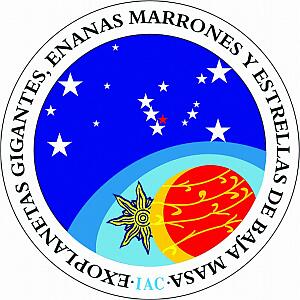 | |||
|
| Home > Public Information > ING Newsletter > No. 9, March 2005 > Direct Detection of Giant Exoplanets |
|
|
SCIENCE |
|
|
|
Previous: Wide Field Survey: Final Data Products | Up: Table of Contents | Next: LIRIS Observations of SN 2004ao
 | |||
|
| Home > Public Information > ING Newsletter > No. 9, March 2005 > Direct Detection of Giant Exoplanets |
|
|
SCIENCE |
|
|
|

|
| Logo of the JOVIAN Project. [ JPEG | TIFF ]. |

|
| Figure 1 (left). JHKs composite image of the
G196-3AB system. The images were taken with the NAOMI+INGRID Adaptive Optics
system at the William Herschel Telescope. North is up and East is left.
Size is 41 arcsec´41 arcsec. G196-3A, an extremely young nearby M star,
is in the centre of the field of view. G196-3B, 13.5 arcsec to the SWS, is
a late L spectral type brown dwarf that shares common proper motion with
the A component. Estimated mass of G196-3B is 25MJup or less. These images
are sensitive to discover superjupiters at separations >50 AU to the central
star. Figure 2 (right). Same as previous figure, but for the V639 and V647 Herculis system. The double object at 6.5 arcsec SSE of the brightest star is a blue background object of unknown nature. It does not belong to the stellar system. The FWHM of the JHKs images is better than 0.2 arcsec. [ JPEG | TIFF ]. |

|
| Figure 3. The σ Orionis region and the WFC surveys. The bright star to the up left corner (North East) is Alnitak, one of the stars of the Orion Belt. Blue background: I-band image from Digitised Sky Survey. Coloured intermediate level: WFC survey in VRI-bands (note the emission in R band (or Hα) of the nebula associated to Alnitak and the Horsehead Nebula). Grey foreground: very deep I-band WFC survey (Ilim about 24.5). [ JPEG | TIFF ]. |

|
| Figure 4. Pictorical view of several isolated
planetary-mass objects (IPMOs) in the σ Orionis cluster
(Zapatero
Osorio et al., 2000). [ JPEG | TIFF ]. |

|
| Figure 5. Near-infrared image of S Ori 70 (marked with two lines), overimposed onto a Digitised Sky Survey image centred in the multiple stellar system s Orionis, that gives the name to the cluster. The mass of S Ori 70 is calculated to be in the range 2 to 8 Jupiter masses. [ JPEG | TIFF ]. |
| Top | Back |
|